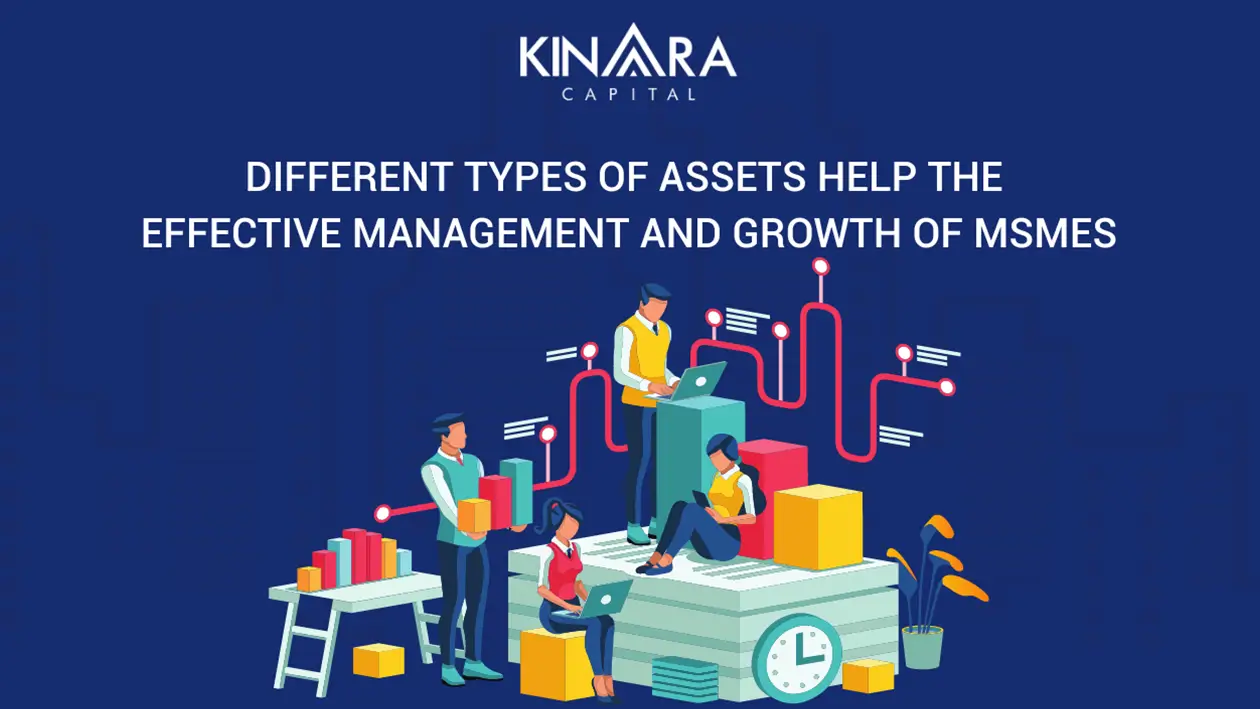
The growth of MSMEs, or Micro Small and Medium Enterprises, holds paramount importance for India as it serves as a key driver of the country’s socioeconomic development. These enterprises make substantial contributions to employment generation, innovation, and overall industrial progress. Assets, on the other hand, play a crucial and irreplaceable role in elevating the overall business value, generating revenue, and ensuring smooth day-to-day operations.
Business assets encompass a synergistic blend of various types, collectively driving the success and growth of MSMEs. These serve as catalysts, empowering businesses to flourish within their respective niches and effectively scale their operations, ultimately gaining a competitive advantage. Strategically leveraging physical, financial, and intangible assets can propel the growth of MSMEs and take them to new heights.
By recognising the vital role that each asset type plays in the growth equation, MSMEs can harness their combined power to drive innovation, optimise performance, and navigate challenges in the dynamic business landscape. In this article, we delve into the integral role played by different asset types in the growth of MSMEs, offering insights and strategies to unlock their full potential and achieve sustainable success in the competitive marketplace.
Small business owners must be adept at identifying and exploiting the diverse array of assets, thereby propelling their business forward. Leveraging different types of assets effectively can enhance the competitive edge and establish a solid foundation for the growth of MSMEs. Thus, acknowledging their significance and mastering their utilisation becomes a fundamental element in the journey of a small business owner aiming to thrive and succeed in the ever-evolving business landscape.
Assets represent valuable resources owned by a business enterprise, possessing economic value that holds the potential to yield future benefits. They are integral to the functioning and success of businesses, and their presence is recorded on the balance sheet. They have the ability to generate immediate or future cash inflows, contributing to the overall financial well-being of the company.
Entrepreneurs can determine the value of their business by calculating the difference between the company’s assets and liabilities, employing the asset-based approach for evaluation. This approach provides a tangible and quantifiable measure of the business’s worth, allowing entrepreneurs to gauge their financial position and make informed decisions.
Understanding the nature and significance of assets can help effectively manage and leverage to maximise and profitability and growth of MSMEs. Assets are a foundation upon which businesses build their operations, seize opportunities, and navigate challenges, positioning them for sustained success in the ever-evolving marketplace. Here is a detailed look at the different types of categories.
Assets can be classified into different categories, each serving a specific purpose in the business landscape. Understanding these categories is essential for effective asset management and growth of MSMEs.
Current assets encompass resources that can be readily utilised within a year of business operations. They include cash equivalents, cash, inventory, pre-paid liabilities, accounts receivable, and other liquid assets. These provide the necessary liquidity to support day-to-day operations and meet short-term obligations.
Intangible assets, although not physically tangible, hold significant value for a company. They may not be reflected on the balance sheet, but they greatly contribute to the overall asset value. Examples include trademarks, patents, licenses, and goodwill. These can play a pivotal role in establishing brand recognition, protecting intellectual property, and enhancing the company’s reputation.
Fixed assets are essential for the long-term sustainability of a business. These physical assets, such as machinery, land, buildings, and vehicles, provide the infrastructure and resources necessary for operational continuity. These are typically held for an extended period and contribute to the production or delivery of goods and services.
Non-operating assets, do not directly impact routine operations but still have the potential to generate income. Examples include vacant land, unused equipment, loans receivable, short-term investments, and fixed deposits. While not actively involved in daily operations, these can provide additional financial stability and growth opportunities for a small business.
Operating assets are directly involved in the day-to-day operations of a business. They include cash, machinery, equipment, prepaid expenses, and accounts receivable. Operating assets are critical for the smooth functioning of the business, enabling it to deliver products or services, manage expenses, and generate revenue.
By understanding the different types of assets and their respective roles, businesses can make informed decisions about asset allocation, maximise utilisation, and optimise their overall financial performance. Effective management of assets across these categories contributes to business stability, growth, and long-term success.
Assets undeniably hold a pivotal role in driving the expansion of small businesses. They serve as crucial indicators of a company’s financial standing, encompassing both tangible and intangible resources. Understanding the distinct types of assets becomes paramount for MSMEs aiming to thrive in a fiercely competitive environment. However, the question arises: is the mere acquisition of assets sufficient to ensure the steady growth of MSME? While asset acquisition is important, the true catalyst for enterprise growth lies in asset building.
Let’s explore some effective strategies that can assist small businesses in cultivating and enhancing their base:
Recognise the immense value of employees as valuable assets. By offering competitive compensation aligned with industry standards, MSMEs can transform their workforce into a robust asset foundation. Prioritizing employee retention over frequent turnover enables the cultivation of a skilled and dedicated team, fostering long-term stability and growth of MSMEs.
Place emphasis on building a strong brand presence. Invest in activities that enhance brand recognition and reputation, such as strategic marketing campaigns, effective customer relationship management, and consistent brand messaging. Building a reputable brand contributes to intangible assets such as customer loyalty and brand equity, boosting the overall value of the business.
Organisations need to foster a culture of innovation to stay ahead of the competition and thrive in today’s ever-changing marketplace. This means encouraging employees to think outside the box, come up with new ideas, and take risks. It also means investing in research and development, protecting intellectual property, and actively seeking product or service diversification opportunities. These efforts enhance intangible assets and pave the way for sustained growth of MSMEs and differentiation in the marketplace.
By implementing these asset-building strategies, small businesses can fortify their foundations and position themselves for long-term success. While asset acquisition lays the groundwork, proactive building is the key to unlocking substantial growth opportunities and thriving amidst evolving market dynamics.
The role of different types of assets in the growth of MSMEs cannot be overstated. They are the backbone of a small business, enabling owners to assess their financial standing and make informed decisions. Understanding and utilising various categories are essential for MSMEs to thrive in a competitive environment.
While acquiring assets is important, it is the active process of building assets that drives the growth of MSMEs. This involves strategic initiatives such as investing in the workforce, building a strong brand, fostering innovation and intellectual property, and optimising operational processes. By focusing on asset building, MSMEs can strengthen their foundations, enhance their competitive advantage, and unlock long-term growth opportunities.
The workforce emerges as a valuable asset, and investing in employee development and retention pays dividends in terms of loyalty and productivity. Brand-building activities contribute to reputation and customer loyalty, while innovation and intellectual property protection foster differentiation and value creation. Streamlining operational processes increases efficiency and frees up resources for further asset development.
A leading last-mile lending firm, Kinara Capital provides collateral-free business loans to aid MSMEs in purchasing the required machinery to expand their business operations with ease. MSMEs can apply for a business loan by downloading the myKinara app or visiting Kinara’s website and taking the 1-minute eligibility test. If MSMEs need further assistance, a local Kinara officer will visit them and help through the entire loan application process in their preferred vernacular language. Also, we have a dedicated customer support team available between Monday – Friday (9.30 AM – 6.00 PM) at our toll free number 1800-103-2683 for any questions or assistance. This ensures that entrepreneurs can get the help they need throughout the loan process.
